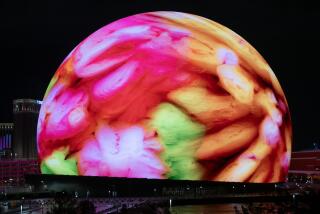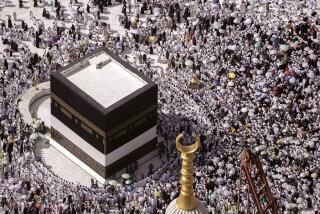Redesign of Mecca Sound System a Job of Epic Proportions
- Share via
To someone less versed in extremes, the project specifications might have seemed absurd.
Design a sound system that can be heard without distortion by millions of people for several miles around. Back it up so even if dozens of microphones fail, a control room bursts into flames and two nearby power plants are bombed, the program continues.
Do it for a venue in the Saudi Arabian desert without ever setting foot there--not to design the system, not to install it, not even to trouble-shoot it.
The upgrade of the sound system at the Holy Mosque at Mecca--the center of worship for Muslims--is one of the most unusual engineering projects ever undertaken--perhaps unmatched in scope and sacred importance.
It is a task that fell in large part to Los Angeles automation wizard Dennis M. Kornegay. Kornegay’s niche is in extremes, although his United Automation Inc. has catered more to the fabulously wealthy than to the religiously observant.
He recently programmed the high-end suites at Mirage Resorts’ $2-billion Bellagio hotel in Las Vegas, where guests use computer touch-screens to control everything from video and lights to their gas fireplaces. He has customized private estates of Mirage Resorts Chairman Steve Wynn and Michael Milken and headed automation efforts at the Getty Center. Other entertainment projects crowd his resume.
Nothing has come close to the Mecca job in historical significance, unusual working conditions or sheer size. The task of rewiring Islam’s holiest site has brought the latest technology together with ancient ritual and forged an unusual alliance between Saudi religious authorities and a man who once automated the “Jeopardy” game board.
Kornegay was responsible for automation of the fully computerized Mecca system. He teamed up with Los Angeles-based Acromedia Corp., which was approached by the Saudis and handled the electronics.
Non-Muslims are forbidden to enter Mecca, so Kornegay and Acromedia project manager Bob Patrick trained a team of visiting Saudi Arabian technicians to install and run the system.
Since no noise can be transmitted over the system save the voice of the imam, or prayer leader, reading from the Koran (or a recording of the imam reading from the Koran), they devised a way to test the 6,000 speakers without sound.
Special care was taken not to damage the mosque’s centuries-old marble walls--a feat requiring that 25 million feet of wiring be laid in existing joints and crevices. And since everything uttered on the system is holy--and no prayer can be interrupted--it simply cannot fail.
“It has to work, and it has to work five times a day, 365 days a year,” Kornegay said. “There’s no cutting slack for, ‘Oh, we’re going to miss a prayer today.’ The level of redundancy is incredible.”
Prayer Services Heard Miles Around
A hajj, or pilgrimage, to Mecca--birthplace of the 7th century prophet Muhammad--is one of the five pillars of Islam, required of all Muslims, health and finances permitting.
But the sanctity of the mosque predates even Muhammad. Located in its center is the Kaaba, which Muslims everywhere face in prayer five times daily. According to Islam, the cube-like structure was built on Allah’s order by Abraham and his son Ishmael.
At peak times, 1 million worshipers crowd inside the mosque for congregational prayer, with 2 million more outside its gates. Individual devotees circle the Kaaba counterclockwise 24 hours a day.
Technology already has transformed the way Muslims worship. Daily prayers from the Holy Mosque are beamed worldwide via satellite. Satellite-based hand-held devices tell Muslims precisely when to stop for prayer and which direction to face in order to align with the Kaaba.
Now with the upgraded sound system, millions of worshipers as far as 3 1/2 miles away should be able to hear the imam’s words free from feedback or distortion.
While the mosque’s current 20-year-old sound system is manual, the new one is driven by 14 main computers--seven in a back-up control room “in case one goes on fire,” Kornegay said. Other highlights: 380 amplifiers, each equipped with two computers, and 126 microphones for use at seven locations around the Kaaba.
Each microphone stand has nine mikes, three for standing, three for kneeling and three for the imam’s prone position, in case the first and second mikes fail. But that’s not all. “If something goes wrong with those nine mikes, the imam can go and grab another stand with nine more mikes,” Kornegay said.
Each rack of seven amplifiers contains an eighth as a spare. The backup system is wired to a second power plant, in case the first plant fails. If both go down, battery back-up will carry the system through at least the length of one prayer.
That amount of back-up “is unheard of,” Kornegay said. “No one cares that much.”
Muzzamil Siddiqi, an Orange County Islamic leader and president of the Islamic Society of North America, called the undertaking “a great honor” for United Automation and the other companies involved.
“You feel that you are in touch with paradise,” Siddiqi said of visiting the mosque. “Millions of people have been circling [the Kaaba] for 1,500 years in constant prayer. There is a feeling of high voltage.”
“It is a very good investment for Islam,” Jamal Nasef, spokesman for the Saudi Arabian Embassy in Washington, said of the project. Other recent upgrades to the mosque include the replacement of the Kaaba’s wooden door with one of solid gold, he said.
A demonstration of the system--now being installed--is scheduled this month for Saudi King Fahd ibn Abdulaziz al Saud, who bears the title custodian of the two holy mosques (the second mosque is in Medina).
Acromedia, which had designed the sound systems at the Riyadh airport and the mosque at Medina, approached Kornegay about Mecca in 1996. Competing with a European group, they won the job and began two years of design meetings in Cairo and London with mosque technicians.
Kornegay’s role included programming computer systems that detect failure early and take action to avert it. Other software continually adjusts the system’s sound quality. And a giant 3-D computer model enables technicians at the mosque to make additional adjustments by clicking on a screen.
Acromedia, which declined an interview, handled the electronics. Simply put, it calculated how much sound is needed and how to deliver it. The system’s 6,000 speakers and custom-designed fiberglass speaker horns came from Massachusetts-based Bose, and Petaluma-based Apogee Sound Inc. provided the amplifiers.
Language barriers and cultural hurdles caused some frustration, Kornegay said. The Saudis “just assumed we would give them a great system . . . but every time we’d meet, we’d learn something new about what they wanted and improve [it],” in some cases redoing months of work.
Last spring the team rented a Culver City warehouse to assemble the massive system, pinning a wrinkled blow-up photo of the mosque above them to remind them of their mission. In July, six Muslim mosque technicians flew to Los Angeles to learn how to install and run the system.
The project is a gift to the mosque by the Bin Laden Group of Saudi Arabia, the family-run construction empire notorious for its exiled son, Osama bin Laden, booted from the family and country and facing indictment for the August U.S. Embassy bombings in Kenya and Tanzania.
Daily news accounts of Bin Laden’s exploits during the technicians’ visit made them “nervous” that Americans would mistake all Muslims for extremists, Kornegay said.
Automation Firm’s Wide-Ranging Projects
For Kornegay, the project provided incentive to research Islam and study Arabic. It has taken his small company a long way from its roots.
Kornegay and a partner--no longer involved--launched United Automation in 1983 to offer computerized psychological testing to doctors and hospitals. They soon branched into entertainment, devising the first computer-based TeleprompTer and creating writing rooms for Hollywood production teams so everyone could look at the same script on enlarged computer screens.
At the Getty Center, his company outfitted 28 rooms with automated systems, along with several multimedia art displays. “They basically showed me the way the world should work in terms of automation,” said Steph Dirden, the Getty’s head of audiovisual services. “I’m amazed at their capabilities.”
Kornegay declined to disclose the cost of the Mecca project. United Automation’s annual revenue has reached $1.4 million, he said. He employed a dozen people during the height of the Mecca project, but now employs four.
Kornegay also has carved a niche in the elite area of customized integrated automation--programming the Bellagio villas and private estates so all electronics gear can be controlled from computer touch-screens.
“It’s a real strange collection of projects he’s worked on,” said Larry Spurgeon, director of entertainment technology for Mirage Resorts. “It’s a highly specialized niche and not too many people can fill it.”







